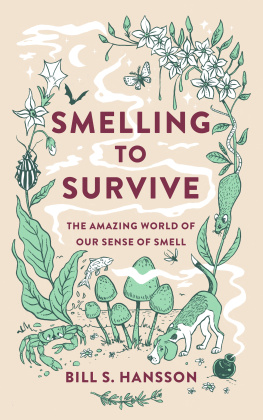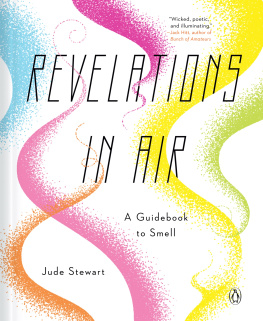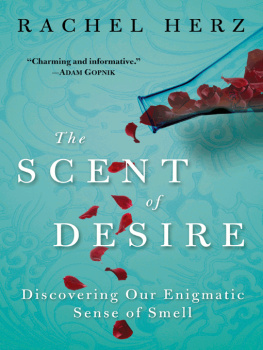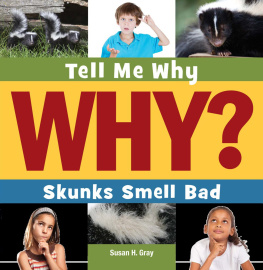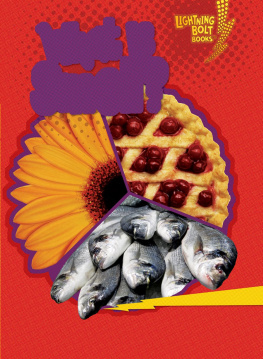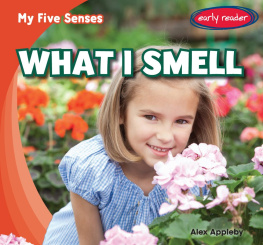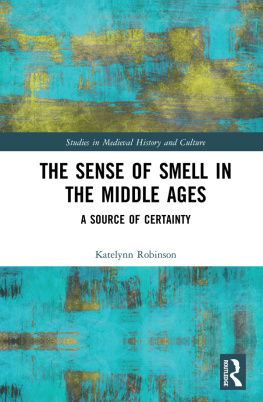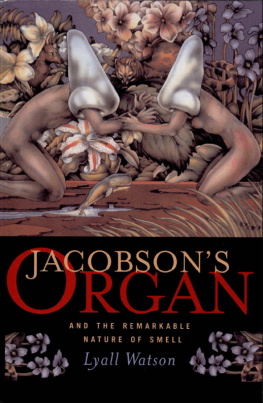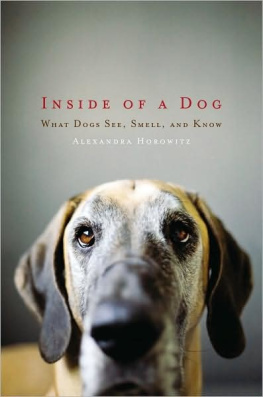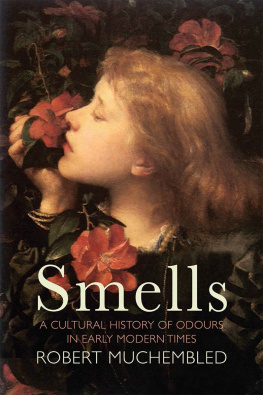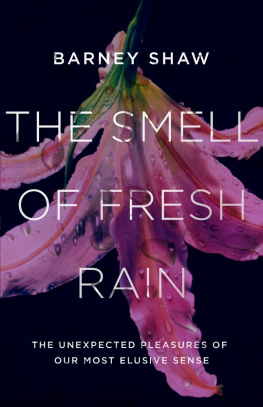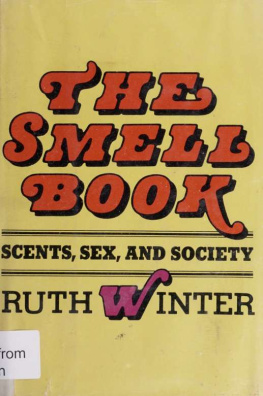Contents
Guide
SMELLING TO SURVIVE
SMELLING TO
SURVIVE
The Amazing World of
Our Sense of Smell
Bill S. Hansson

HERO, AN IMPRINT OF LEGEND TIMES GROUP LTD
51 Gower Street
London WC1E 6HJ
United Kingdom
www.hero-press.com
Originally published in German as Die Nase vorn. Eine Reise in die Welt des Geruchssinns by S. Fischer Verlag in 2021
First published in English by Hero in 2022
2021 S. Fischer Verlag GmbH, Frankfurt am Main
The right of Bill S. Hansson to be identified as the author of this work has been asserted in accordance with the Copyright, Designs and Patents Act 1988. British Library Cataloguing in Publication Data available.
Front cover design and illustration by Laura Brett
Printed and bound by CPI Group (UK) ltd, Croydon, CR0 4YY
ISBN: 978-1-91505-449-4
All rights reserved. No part of this publication may be reproduced, stored in or introduced into a retrieval system, or transmitted, in any form or by any means (electronic, mechanical, photocopying, recording or otherwise), without the prior written permission of the publisher. This book is sold subject to the condition that it shall not be resold, lent, hired out or otherwise circulated without the express prior consent of the publisher.
Contents
Introduction
Its spring and the fields are freshly ploughed. Theres a very special, pleasant smell in the air. If youve ever experienced such a moment, the smell signifies exactly this situation in your brain. Springtime, open soil, farmland. Maybe youre thrown back in time by a memory you didnt even know you had. Few sensory experiences are as good at recalling earlier experiences as olfactory ones (smell). It seems like the memories are simply lying in wait for the right odour to trigger them once again.
One of the most powerful examples in literature of the memory-unlocking ability of smell is found in the first of Marcel Prousts seven-volume masterpiece In Search of Lost Time. It opens with the sweet smell of madeleines, miniature sponge cakes, evoking involuntary memories of the authors childhood and adult life. But smell is not a sense that is unique to humans.
All organisms, with and without backbones, from insects to humans, use sensory systems to make sense of their environment and to communicate with each other. During the course of evolution, different species have become more or less dependent on a certain kind of information. Crickets and bats rely heavily on sound waves, dragonflies and humans often put their trust in sight, while moths, pigs and dogs are famous for their keen sense of smell.
As humans are indeed very visual beings, we tend to forget the other senses. Especially our own sense of smell. This is partly because we are less dependent on chemical information nowadays. But there is also something quite primitive about smell. Something we want to avoid. Just think about the lengths we go to in order to disguise our own, natural smells, to cover them with artificial odorants or to prevent them with deodorants. We may think we are less dependent on olfactory information than other species, but we arent really. Many vital aspects of our lives depend heavily on smells. I will explore why and how in my chapter about the human sense of smell.
For other animals, an acute sense of smell is absolutely vital for survival and reproduction. Back in the 1800s, when the French entomologist Jean-Henri Fabre noticed how huge numbers of male moths were attracted to a caged female in his house, he assumed that odours were involved. We now know that he was on the right track. The male moth can follow the female scent, a trail close to homeopathic concentration given off by the female, making him probably the best smeller of them all.
When salmon returns to spawn in the same river branch where it was born, it uses smell to find its way. Without its sense of smell, it would be lost. So specific are the odours in the water that each river tributary has its own signature. Male dogs are as keen as moths, if not as sensitive, to find the bouquet of a female in heat. Even so, dogs are a thousand times more sensitive to smell than we humans. Its an ability that weve put to good use in many contexts, including for hunting and tracking, for locating earthquake victims and even for diagnosing cancer. For dogs, life is lived much more in a landscape of odours rather than visuals. As such, dogs see history as odours, not as visual impressions. Smells linger on and can tell them what happened or who passed by long after anyone saw it.
For a long time, birds were believed to have no or a very poor sense of smell. Today, we know otherwise. Vultures can pick up the scent of the distinct molecules emitted from a dead animal from far, far away. While seabirds, such as albatrosses, can smell their way to an ample supply of plankton, which in turn means good opportunities for fishing.
Whats even more surprising perhaps is the fact that plants can smell and send odour messages to each other. They also use specific odours to manipulate friends and foes. When a plant is attacked, for instance by moth larvae, it changes its emission of volatiles. These molecules can have two different positive effects for the plant. They warn neighbours of the same species that an attack is going on, so that they can turn on their defence system before the herbivores get to them. The volatiles can also serve as a call for help by attracting enemies of the attackers. Your enemys enemy is your friend, even in the plant world.
In another context, plants have evolved to attract the insects they are dependent on for pollination. Normally, this is a process that is a win-win for both players. Sometimes, however, the plant cheats the insects into doing the job without any payback whatsoever.
From all these examples, its obvious that most organisms on earth are dependent on odour information to survive and reproduce. Being able to sense your chemical environment allows you to adapt to the surrounding conditions, find a resource or a mate and avoid different types of enemies, toxic substances and disease agents.
Before we can understand how smell works, we need to understand what smell really is. Both smell and taste consist of chemical information. The molecules in a water solution give us taste, while in air they give us smell. For something to smell it has to emit molecules light enough to take flight. A piece of sugar doesnt smell, as the molecules are too heavy to take off. While no one would mistake the molecules escaping from a lemon for anything else. The limonene and citral molecules fly easily towards our nose.
All emitted molecules however are not odours. Only when they can be detected by another organism do they contribute to the smell, for example, of a banana. The number of molecules emitted is impressive. A banana sends out hundreds of different molecules. Only a few of these are indeed odours detected by an insect or the human nose, while all the others are just volatile molecules.
To detect smells, all animals need some kind of detector system. To perform this task a specific part of the nervous system has to make contact with the environment and must be endowed with specific receptors to recognize relevant molecules. Our nose is actually the only place where our nervous system is in direct contact with our surroundings. The nerves hang out into the environment. Well, not quite, as they swim in a sea of snot inside your nose. But still, they are exposed to all kinds of pollutants and dust that enter the nose together with smells. Nerves can, however, neither see nor smell. They need to be equipped with some detectors, so-called receptors, to perform.

